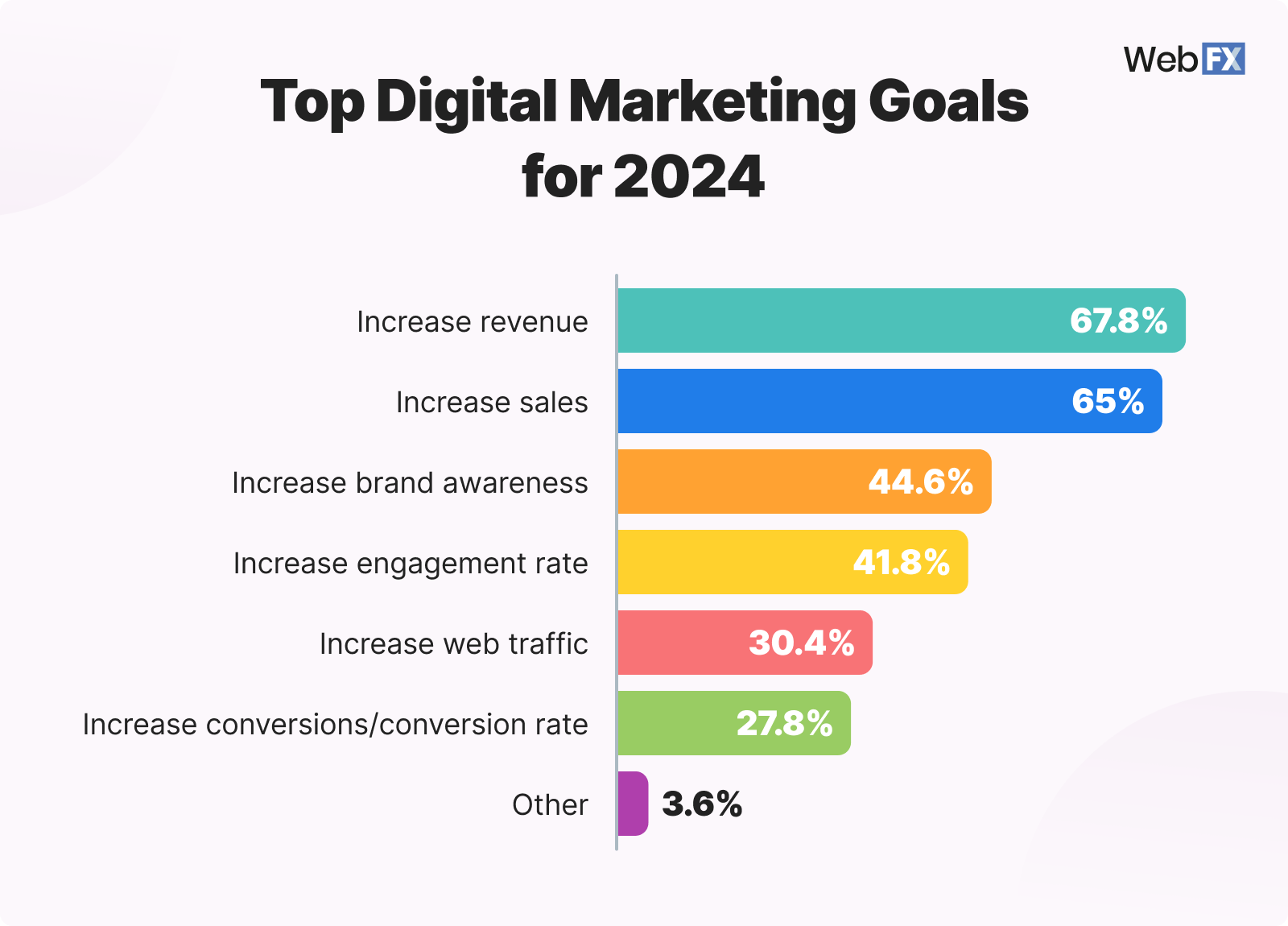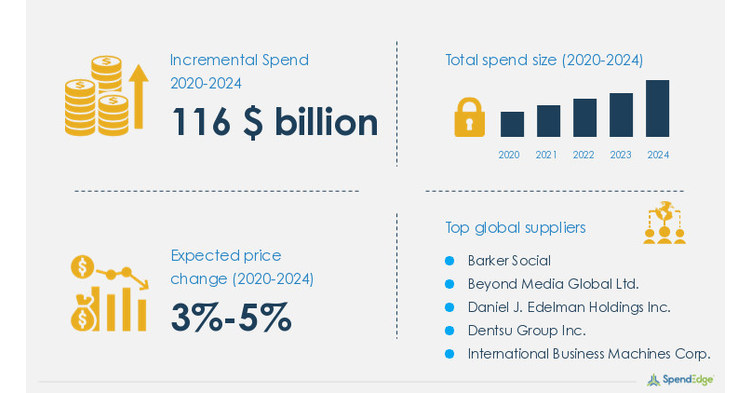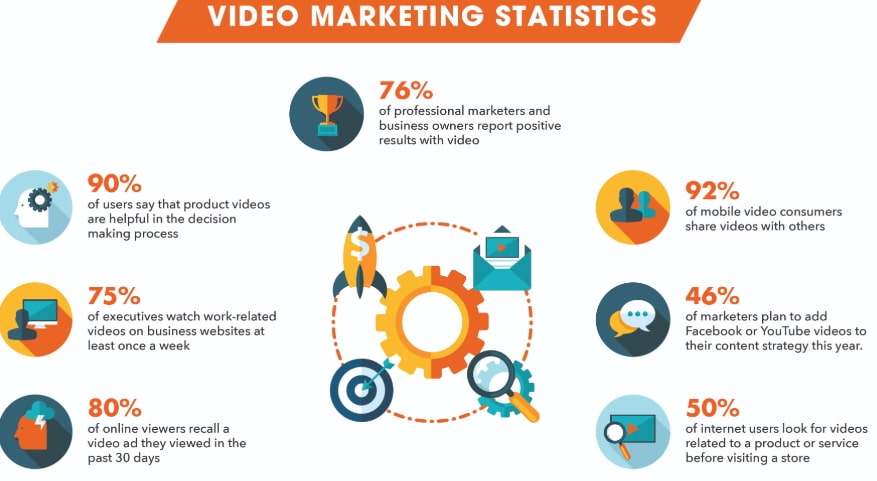In this article, we will learn how marketers should spend their money in 2024 according to the change in trends in recent years.
Top 12 Digital Marketing Goals You Must Set in 2024
1. Increase Revenue
ROI refers to the revenue generated from a marketing campaign compared to the amount spent on it. Marketers may increase their revenue after tracking ROI through metrics such as cost per acquisition, return on ad spend (ROAS), or customer lifetime value (CLV).
2. Increase Sales
Marketers can increase sales by making informed decisions about how to optimize their campaigns and allocate their budget for maximum impact.
3. Increase Brand Awareness
Brand awareness refers to how well a brand is recognized and remembered by audiences. Marketers may track brand awareness through metrics such as brand recall, brand recognition, or sentiment analysis.
4. Increase Engagement Rate
Engagement refers to how audiences interact with a marketing campaign. Marketers may track engagement through metrics such as likes, comments, shares, or click-through rates.
5. Increase Website Traffic
Reach refers to the number of people who have seen or been exposed to a marketing campaign. Marketers may track reach through website traffic, social media impressions, or email open rates.
6. Increase Conversions
Conversions refer to the number of people who take a desired action as a result of a marketing campaign, such as making a purchase or filling out a form. Marketers may track conversions through metrics such as conversion rates, sales revenue, or lead generation.
7. Digital Advertising
With the rise of technology and the internet, digital advertising has become a crucial component of many companies' marketing strategies. Marketers often allocate a significant portion of their budget towards digital ads, including social media ads, display ads, and search ads.
8. Content Marketing
9. Influencer Marketing
10. Events and Sponsorships
11. Data Analysis and Marketing Technology
Marketers often allocate their budgets towards a mix of traditional and digital marketing strategies, with a focus on creating engaging content and leveraging technology to better understand and engage with their target audiences.
5 Metrics To Measure The Success of Marketing Campaigns
Marketers use a variety of metrics to measure the success of their campaigns, depending on their specific goals and objectives. Here are 5 common metrics that marketers use to track the effectiveness of their campaigns in 2024:
1. Post and Page Reach
2. Post Engagement and Comments
3. User Behavior and Website Conversions
4. Return on Investment (ROI)
5. Brand Awareness and Connections
Optimize Marketing Campaigns Based on These Metrics
You can optimize the marketing campaigns based on these metrics. Track and make data-driven decisions to improve performance. Here are examples of how you can do that:
1. Use A/B Testing
A/B testing involves creating two versions of a marketing campaign and testing them against each other to see which performs better. Marketers can use A/B testing to optimize various elements of their campaigns, such as the subject line of an email or the call-to-action button on a landing page.
2. Optimize Targeting
Marketers can use data on their audience demographics and behavior to refine their targeting strategies. For example, they may choose to target specific age groups or geographical locations based on data that suggests those groups are more likely to engage with their content.
3. Adjust Ad Spend
Marketers can use data on the performance of their campaigns to adjust their ad spend accordingly. For example, if a certain ad is performing well, they may choose to allocate more budget to that ad, while reducing spend on underperforming ads.
4. Improve Content
Marketers can use data on engagement metrics to identify which types of content are resonating with their audience and create more of it. For example, if a certain blog post receives a high number of social shares, they may create more similar content to drive engagement.
5. Optimize Landing Pages
By using data to inform their decisions, marketers can optimize their campaigns to achieve better results and maximize their return on investment.
Example Of A/B Testing
Here's an example of how you can use A/B testing to optimize the subject line of an email campaign:
Let's say you are planning an email campaign to promote a new product and want to test two different subject lines to see which one performs better. You are creating two versions of the email campaign, each with a different subject line, and send each version to a randomly selected part of the email list.
Here's what you might do:
Version A:
Subject line: "Introducing our new product: Get 10% off today!"
Version B:
Subject line: "Don't miss out on our new product – get 10% off now!"
After sending the emails, you should collect data on the open rates of each email to see which subject line performed better. Let's say the results showed that version A had an open rate of 25%, while version B had an open rate of 30%.
Based on these results, the marketer would conclude that version B's subject line was more effective, and would use that subject line for the remaining part of their email list.
Here you should also note that now worked better than today which means people are more likely read emails and posts that shows urgency.
In the similar way you are planning an event. Don't send the email 2-3 weeks in advance because people generally find an excuse after becoming excited to attend it.
You should send the email 2-3 days prior to the actual date. It is more like I am creating a free webinar online. However the chances are more that you will get excited initially and might become lazy afterwards.
You can also use this information to take informed decisions in future related to email campaigns, using similar language and messaging that resonated with the audience in the A/B test.
Conclusion
A/B testing allows you to make data-driven decisions and optimize your campaigns for better results. By testing different elements of the campaigns, such as subject lines, images, or calls-to-action, you can understand what resonates with the audience and continually improve the performance.






























0 Comments